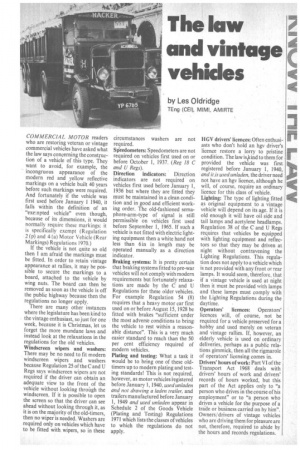The law and vintage vehicles
Page 29

If you've noticed an error in this article please click here to report it so we can fix it.
by Les Oldridge
TEng (CEI), MIMI, AM1RTE COMMERCIAL MOTOR readers who are restoring veteran or vintage commercial vehicles have asked what the law says concerning the construction of a vehicle of this type. They want to avoid, for example, the incongruous appearance of the modern red and yellow reflective markings on a vehicle built 40 years before such markings were required. And fortunately if the vehicle was first used before January 1 1940, it falls within the definition of an "exempted vehicle" even though, because of its dimensions, it would normally require these markings: it is specifically exempt (Regulation 2 (p) and 4 (a) Motor Vehicle (Rear Markings) Regulations 1970.) If the vehicle is not quite so old then I am afraid the markings must be fitted. In order to retain vintage appearance at rallies, it may be possible to secure the markings to a board, attached to the vehicle by wing nuts. The board can then be removed as soon as the vehicle is off the public highway because then the regulations no longer apply.
There are many other instances where the legislature has been kind to the vintage enthusiast, so just for one week, because it is Christmas, let us forget the more mundane laws and instead look at the relaxations in the regulations for the old vehicles.
Windscreen wipers and washers: There may be no need to fit modern windscreen wipers and washers because Regulation 25 of the C and U Regs says windscreen wipers are not required if the driver can obtain an adequate view to the front. of the vehicle without looking through the windscreen. If it is possible to open the screen so that the driver can see ahead without looking through it, as it is on the majority of the old-timers, then no wiper is needed. Washers are required only on vehicles which have to be fitted with wipers, so in these circumstances washers are not required.
Stieedometers: Speedometers are not required on vehicles first used on or before October 1, 1937. (Reg 18 C and U Regs).
Direction indicators: Direction indicators are not required on vehicles first used before January 1, 1936 but where they are fitted they must be maintained in a clean condition and in good and efficient working order. The old-fashioned semaphore-arm-type of signal is still permissible on vehicles first used before September 1, 1965. If such a vehicle is not fitted with electric lighting equipment then a white hand not less than 6in in length may be operated manually as a direction indicator.
Braking systems: It is pretty certain that braking systems fitted to pre-war vehicles will not comply with modern requirements but fortunately relaxations are made by the C and U Regulations for these older vehicles. For example Regulation 54 (8) requires that a heavy motor car first used on or before August 15, 1928 be fitted with brakes "sufficient under the most adverst conditions to bring the vehicle to rest within a reasonable distance". This is a very much easier standard to reach than the 50 per cent efficiency required of modern vehicles.
Plating and testing: What a task it would be to bring one of these oldtimers up to modern plating and testing standards! This is not required, however, as motor vehicles registered before January 1, 1940, used unladen and not drawing a laden trailer, and trailers manufactured before January 1, 1949 and used unladen appear in Schedule 2 of the Goods Vehicle (Plating and Testing) Regulations 1971 which lists the classes of vehicles to which the regulations do not apply. HGV drivers' licences: Often enthusiasts who don't hold an hgv driver's licence restore a lorry to pristine condition. The law istkind to them for provided the vehicle was first registered before January 1, 1940, and iris used unladen, the driver need not have an hgv licence, although he will, of course, require an ordinary licence for this class of vehicle.
Lighting: The type of lighting fitted as original equipment to a vintage vehicle will depend on its age. If it is old enough it will have oil side and tail lamps and acetylene headlamps. Regulation 38 of the C and U Regs requires that vehicles be equipped with lighting equipment and reflectors so that they may be driven at night without contravening the Lighting Regulations. This regulation does not apply to a vehicle which is not provided with any front or rear lamps. It would seem, therefore, that if a vintage vehicle is used at night then it must be provided with lamps and these lamps must comply with the Lighting Regulations during the daytime.
Operators' licences: Operators' licences will, of course, not be required for a vehicle preserved for a hobby and used merely on veteran and vintage rallies. If, however, an elderly vehicle is used on ordinary deliveries, perhaps as a public relations gimmick, then all the rigmarole of operators' licensing comes in.
Drivers' hours of work: Part VI of the Transport Act 1968 deals with drivers' hours of work and drivers' records of hours worked, but this part of the Act applies only to "a person who drives in the course of his employment" or to "a person who drives a vehicle for the purpose of a trade or business carried on by him". Owners/ drivers of vintage vehicles who are driving them for pleasure are not, therefore, required to abide by the hours and records regulations.




















































































